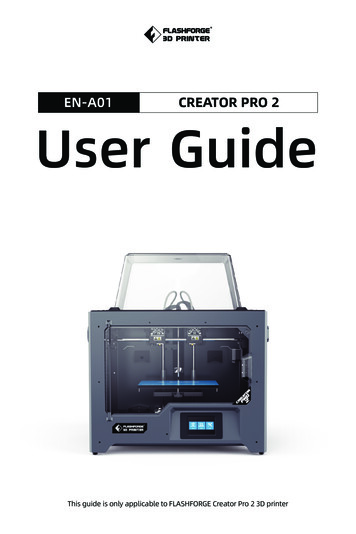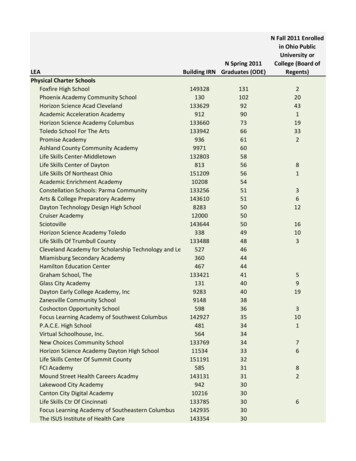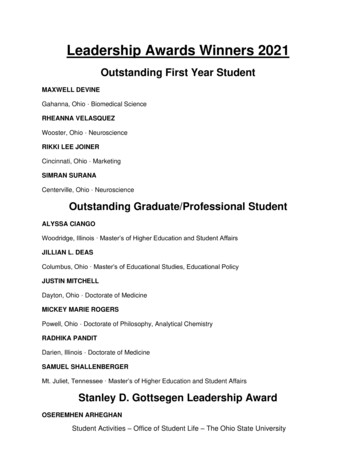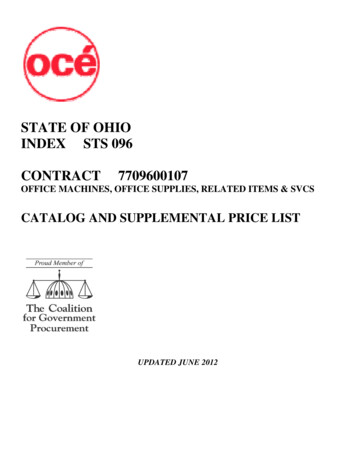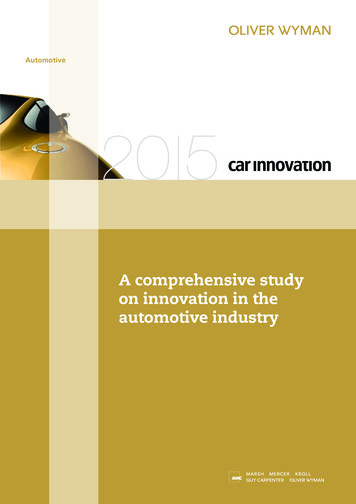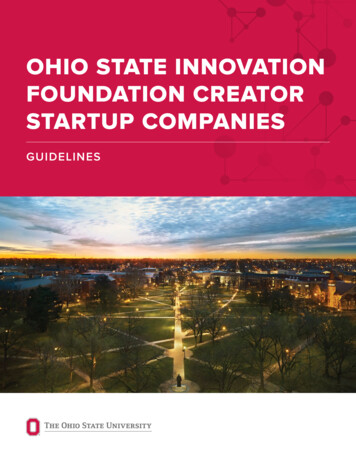
Transcription
OHIO STATE INNOVATIONFOUNDATION CREATORSTARTUP COMPANIESGUIDELINES
Ohio State Innovation Foundation Creator Startup CompaniesTABLE OF CONTENTSCreator Startup Program Overview 1Creator Startup Program Objectives 2A Pathway for Ohio State Startups 2Steps for Forming a Successful Startup Company 4Business Case 4Funding 5Company Evaluations 7Exit Strategy 7Pitfalls 7OSIF Creator Startup Company Policies 8Technology Criteria 8Creator Obligations 8Startup Obligations 8Licensing Conditions 8Creator Startup Company Terms 9Creator Startup Company Resources 11Frequently Asked Questions 14This guide has been developed to clarify and simplify the process by which faculty and staff creators maystart new companies based on technology created by them at Ohio State. It is intended to establish clear,fair and consistent practices and standards for the formation of an Ohio State creator startup company. Itaccounts for both creators who participate in the startup and those co-creators who do not. Certain sectionscontain information derived from “Stanford University Office of Technology Licensing Startup Guide.” This guidewas written in July 2019 and may be changed in the future. It is not a contract nor an offer to enter into anagreement on these or other terms. Startups created prior to the formation of these guidelines are not eligiblefor renegotiation. Creators should refer to Ohio State’s Intellectual Property Policy and other policies for currentguidelines on intellectual property, conflict of interest and other issues.
CREATOR STARTUP PROGRAMCreator Startup Program OverviewAs part of its mission to facilitate commercialization ofThe Ohio State University’s intellectual property (IP), theOhio State Innovation Foundation (OSIF) is committedto supporting the creation of startups, or newly-formedcompanies. As commercialization vehicles, startups offeressential flexibility to the development of early-stagetechnologies and the speed to enable market disruption.Ohio State encourages innovation and has establisheda variety of mechanisms to support creators in bringingtheir technologies to market through the establishmentof startup companies.The most successful startups are those that have a strong foundational team – consisting of a technology leader(the creator) and a business leader – as well as initial investment capital. Ohio State offers the option for creatorsto recruit and gather these resources on their own or to leverage the Corporate Engagement Office’s network.These creator guidelines have been established to address the increasing number of entrepreneurial creatorsexpressing interest in leading their own startup ventures and assembling the elements necessary for theirsuccess – sometimes referred to as the West Coast model. The guidelines have been benchmarked againstmarket terms of the more efficient startup peer institution ecosystems on the coasts that do not offer the sameservices as OSIF.1Ohio State Innovation Foundation Creator Startup Companies The Ohio State University
Creator Startup Program Objectives1.To facilitate the successful dissemination of technology created at Ohio State for the benefit ofsociety, the State of Ohio, the creators of such technology, Ohio State and OSIF.2. To make Ohio State an attractive environment for highly talented, entrepreneurial faculty, staffand students.3. To assist in Ohio’s economic development.4. To generate a reasonable financial return for the university5. To generate future revenues in the form of gifts and research collaborations fromentrepreneurs and companies who have benefited from technology created at Ohio State.A Pathway for Ohio State StartupsFor some technologies, a startup company is the optimal way to bring the technology to market. Some factorsthat we consider include the development stage of the technology, the size of the problem the technologyaddresses and the impact the technology will have on the market.1. INVENTION DISCLOSUREAs soon as a discovery is made, creators should submit an invention disclosure through Innovate. Theseconfidential, internal, non-public disclosures help protect the intellectual property and serve as a formalcommunication to Corporate Engagement Office of a potential invention (see the university’s IntellectualProperty Policy. A licensing manager will be assigned to the technology within one week of receiving aninvention disclosure.2. FACULTY MEETINGThe licensing manager will contact the creator to better understand the invention. Together, they will brainstormways to add value to the discovery as early in the commercialization process as possible. These could includeidentifying other applicable markets, non-traditional sources of technology advancement funding or ideas forvalidating and testing the technology. Licensing managers will outline initial action steps for both parties.A faculty meeting usually takes place within two weeks of an invention disclosure.3. REVIEW AND ASSESSMENTWith the creator, licensing managers assess the invention for technical merit, maturity, intellectual propertyprotection potential and market impact. This helps to determine what steps can further develop the technologybefore license. The licensing manager researches and identifies the best protection method for the technology andmakes a preliminary assessment of the market landscape and dynamics to understand the invention’s commercialpotential. Depending on the complexity of the technology, the assessment step can take several months.2
A PATHWAY FOR STARTUPS4. INTELLECTUAL PROPERTY PROTECTIONIn the event that the technology commercialization team determines that the invention is best protected bypatent, the team makes initial patent filing decisions and identifies outside patent counsel with expertise in therelevant field. The creator works closely with the licensing manager and the patent counsel to draft relevant,valuable, and enforceable claims based on the nature of the invention, the relevant markets and anticipatedbusiness model for commercializing the invention. Any subsequent patent decisions are made in concert withthe creator and the creator’s college research leadership team.Non-patentable inventions, such as materials, copyrighted works, and certain software, can be protected byother means such as copyrights or contracts. Licensing managers will be able to guide you on the best way toprotect non-patentable inventions.This process begins as early as a month after the invention disclosure and can take up to several years before apatent is secured, depending on the complexity of the technology.5. COMPANY FORMATIONThe management team of a successful startup is comprised initially of a business leader and a technologyleader (at a minimum). The faculty member, or another technology expert such as a post-doc or graduatestudent, is frequently the technology leader. Corporate Engagement’s new ventures team works diligently tofind a business leader with relevant expertise and networks in the technology and/or market. The businessleader is responsible for filing the incorporation documents, negotiating the license agreement, preparing abusiness plan, recruiting additional talent and raising capital for the startup.6. TERMS OF A STARTUP LICENSEThe terms for a startup are designed to help the company launch, enable investment by third parties, and alignthe interests of Ohio State with those of the startup. The primary economic terms include a royalty rate paidupon sales and an equity stake in the startup. The startup is also expected to bear the costs of intellectualproperty protection. In certain cases, where the creator finds the business leader and raises capital, the creatoris eligible for standard (non-negotiated) deal terms.7. NEGOTIATIONSLicensing managers lead license negotiations once a potential licensee is found and determine which type ofagreement – such as a license or option – best fits the situation. To avoid conflicts of interest, creators are notdirectly involved in license negotiations. Once a business leader is identified, the negotiation process can beginwith the business leader. The time necessary to complete a negotiation is determined by the partner and theunique characteristics of the deal.8. PRODUCT SALESIdeally, the commercialization process leads to a product sold on the market returning royalties and otherrevenue to the university that is used for additional research, education and inventive activity. Through the lifeof the license, Corporate Engagement monitors compliance with any agreement and continues to manage allintellectual property activity.3Ohio State Innovation Foundation Creator Startup Companies The Ohio State University
Steps for Forminga Successful Startup CompanyLaunching a successful startup company requirescommitment, dedication and perseverance.Many companies fail even if the core technology is innovative and promising. However, when the righttechnology is implemented at the right time, it has the potential to significantly benefit society. Components ofa successful startup include a compelling concept or technology, a strong market opportunity, a competitiveadvantage, a sound business and financial plan and an experienced management team. Luck and timingare also important. Entrepreneurs spearheading the new company formation will be the key champions forthe technology and the startup. In addition to navigating the standard technology transfer process, they areresponsible for a variety of tasks such as identifying the market opportunity, developing a business planand pursuing financing. Every startup follows its own unique path. There are many common steps to get thebusiness off the ground as outlined in this section.Business CaseEntrepreneurs should develop a thoughtful business case to understand the market potential, competition andfunding needs. This should include a plan for developing the technology and attaining sufficient revenue tosustain and grow the company. This plan will be useful when meeting with investors and pursuing funding.Several key factors should be considered when deciding to form a startup company: Technology innovation and patent/IP position – Is broad patent coverage possible? Can patent claims beenforced against potential competitors? Are there background patents owned by others? Will the companyhave freedom-to-operate to develop the product? Development risk – How far along is the technology? How much time and money is required to bring aproduct to market? What is the regulatory landscape for the envisioned product? Development costs versus investment return – Can investors obtain their required rates of return (e.g., 10Xinitial investment in 5 years)? Product strategy – Does the technology lend itself to opportunities for multiple products/platforms? Market size, dynamics and potential – Is the market big enough? Is it controlled by a few players? Is there ahealthy growth trend? Is there a significant unmet need that the product addresses? Financial potential – What market share can be obtained? Is it worth the effort?4
SUCCESSFUL STARTUPSA business plan should be clear and concise. It will be easier to sell the vision to investors and attractmanagement talent with a formal business plan. Investors are interested in investing in startups with highgrowth potential. The business plan should address what investors want to know: the compelling concept,competitive advantage (including patent/IP position), market and financial potential and proven managementteam. The business plan is generally a confidential document and should be carefully distributed.Components of a typical business plan include: Company name Mission statement – This is the guiding vision for the company. Current market situation – How big is the market? What are its critical problems and shortcomings? How isthe landscape changing? Who is the competition? Is it a consolidated or fragmented industry? The company’s solutions – Which products or methods will be developed? How long will it take? What are itsapplications? What are the company’s unique advantages and are those advantages sustainable? How willthe current market change due to the company’s products, methods, etc.? Patent/IP landscape Marketing and sales strategy – This includes pricing, product and placement. How will the target marketknow about the product? Which sales distribution channels will be used? 5-10 year strategic/financial plan: Financial projections – when will the company break-even? Key milestones required to meet financial projections. Key metrics to be measured and tracked. Key assumptions and how they change based on a competitor’s response. Funding requirements. Management team – This should include members, their roles and their resumes or CVs. Timeline and key milestones Risk factors and mitigation measuresFundingCommercializing technology is typically a capital-intensive process, with the exception of some softwarecompanies. Entrepreneurs need to present their opportunity to people with the funds to help them make ithappen. Typically these are venture capitalists and angel investors – sometimes in the initial stages, investorsinclude friends and family. Using Ohio State’s network is one way to start the personal introduction process thatcan help get the attention of angel and venture capital investors. Collectively, Ohio State startups have raisedmore than 425 million of outside capital to date.The most common forms of technology startup funding are angel investing and venture capital. In the veryearly stages of startups, entrepreneurs raise funds on their own and through friends and family funds. However,technology commercialization often requires multiple rounds of funding from multiple sources.5Ohio State Innovation Foundation Creator Startup Companies The Ohio State University
Angels and venture capitalists are private investors who take on high-risk ventures with goals of high returns.Return requirements vary based on industry and stage of funding, but many investors seek 10X their initialinvestment over 5 years.Angel InvestingAngel investors are typically high-net-worth individuals who have a personal interest in funding new companies.They are often willing to invest in earlier stages and with smaller amounts of money than venture capitalists inexchange for equity. They can take passive or active roles in the startup and typically have a longer investmenthorizon than venture capitalists.Venture CapitalCompared to angels, venture capitalists can invest larger amounts of money (usually millions of dollars) in acompany. In exchange, they tend to receive more equity. Venture capitalists also exercise control and bringexperienced management talent to help guide and grow the company. Sometimes they invest in several roundsof funding and are part of a larger consortium of investors in the company.Non-traditional FundingStartups may also investigate and pursue funding from non-traditional sources. Some examples of these are: SBIR/STTR – Small Business Innovation Research (SBIR) and Small Business Technology Transfer (STTR)offer funding in the form of contracts or grants. This highly competitive program encourages domesticsmall businesses to engage in federal research/research and development (R/R&D) that has the potentialfor commercialization. Currently, eleven federal agencies participate in the SBIR program and fundapproximately 2.5 billion in awards each year. Visit: https://www.sbir.gov/ Banks – Banks do not usually participate in equity investments in new companies, but they are a source ofloans, particularly for capital purchases when there is some kind of collateral (such as large equipment).6
SUCCESSFUL STARTUPSCompany EvaluationsInvestors listen to pitches constantly and only a small portion of startups get funding. The investors willdetermine if the startup meets their strategic and financial goals and if the company fits into their currentportfolio of investments. Venture capital funds are targeting at least an overall 20% annual return on the fundwhich is significantly higher than other investment vehicles such as stocks and bonds.Investors typically perform due diligence before funding new opportunities and they often view the fact thata new company is working with a university positively in this analysis. For example, OSIF’s involvement mayprovide an extra measure of reassurance to investors that IP rights are being properly secured by the company.OSIF will carefully evaluate the patentability and commercial potential of an invention before embarking on thecostly and lengthy process of obtaining patent protection.Funders and Founders offers an infographic explanation of “How Startup Valuation Works - Measuring aCompany’s Potential”.Exit StrategyInvestors plan to recoup their investments via exit strategies. Typically, a venture capitalist hopes to sell itsequity in a portfolio company within 3-7 years, ideally through an initial public offering (IPO) or merger andacquisition by another company.PitfallsNew company formation is a high-risk proposition. While many OSIF startups are successful, others are not.Some common problems that can cause academic startups to fail are: Inexperienced management – A strong, experienced, cohesive team is required for a successful startupcompany. Problems can arise if founders or other members of the team do not have enough startup andbusiness experience or if founders, new management and investors do not have the same strategic vision. Lack of funding – A startup needs sufficient capital to overcome technical challenges, reach critical businessmilestones and progress to the next phase of development. To attract investors, the company must have asolid business plan and a strong management team. Technology does not meet a commercial need – Sometimes the science is innovative and exciting but doesnot correlate to a critical commercial need, or current solutions are still better than the new technology. Timing – Even when a commercial need exists, the company may miss the market. Sometimes this isbecause the market is not ready for a product, because of timing, high cost or an unrecognized need.Sometimes it is because the product is too late to the market and the need has already been filled by adifferent technology or better product. Marginal, niche market – If the target market is smaller than expected the company may not meet itsfinancial targets. Bad luck – Sometimes events outside of the entrepreneur’s control can negatively impact a company.7Ohio State Innovation Foundation Creator Startup Companies The Ohio State University
OSIF Creator StartupCompany PoliciesTECHNOLOGY CRITERIALICENSING CONDITIONS1. All intellectual property rights to be licensed by OhioState or OSIF are not encumbered (i.e., technologyis solely owned by Ohio State or OSIF and not thesubject of any other agreement).2. Technologies in the human health sciences are noteligible for these terms.Upon a determination that the creatorstartup company has met all of thequalification criteria, the startup companywill be eligible to enter into a six-monthexclusive option. During the option period,the startup company will be required to:3. The relevant college and the Corporate Engagement1. Secure a qualified business leader. AOffice agree that no special circumstances exist.CREATOR OBLIGATIONS1. Creator agrees to waive her/his personal share of theuniversity’s proceeds from the license agreement.Because a creator will enjoy greater economicbenefit via their participation in the company andthese standard terms, waiving his or her share ofthe university’s proceeds enables any co-creators toreceive fairer compensation for their inventive efforts.2. All Ohio State employees who are company cofounders have completed a conflict of interest (COI)management plan through the Ohio State Office ofResearch Compliance that is signed off by the deanand department chair.STARTUP OBLIGATIONS1. Startup company and creator(s) must engagetheir own outside legal counsel to represent theirinterests. Our partner, Rev 1 Ventures, maintainsa network of legal firms that work with Ohio Statestartup companies.2. Startup company has appropriate corporategovernance documents (e.g., shareholders’agreement, operating agreement, etc.). OSIF hastemplate corporate governance agreements thatmay be used by the startup company.qualified business leader cannot be auniversity faculty member, employeeor student and must have the requisiteexperience, as determined by thecreators and the new ventures team, tolead the business.2. Submit a detailed business plan. This ismutually-agree-upon with the assignedlicensing manager and new venturesmanager. The university has accessto a number of internal resources andexternal organizations that can assistthe founding team with the creation of abusiness plan.3. Establish majority creator ownership.To qualify as a creator startup company,the cumulative voting interest of OhioState-affiliated creators, after theinitial funding, must be at least 51% ofthe fully-diluted equity of the startupcompany.4. Secure at least 250,000 of funding(dilutive and/or non-dilutive). Toestablish early market validation andsufficiently de-risk the company’scapital requirements, the startup mustsecure 250,000 of financing.8
CREATOR STARTUP COMPANY TERMSCreator Startup Company TermsUpon completion of the required milestones at any timeduring the option period, the creator startup companywill be eligible to enter into a license agreement withthe university.The principal economic terms and conditions described below are intended to be attractive to Ohio Statecreators and competitive with those of other leading research universities and other available alternatives. Theentire license agreement template is available on the CEO website and contains additional terms and conditionsbeyond those described herein. Please note that, in the spirit of these guidelines, these terms will be thestandard that will normally apply; they should not be considered starting points for negotiating more favorableterms for the creators and/or founding team.91. UPFRONT FEE 1,000 per participating creator2. ROYALTY RATE2.5% of net sales of the licensed product(s) (as defined in thelicense agreement) for the life of the patent3. PATENT EXPENSESPast patent expenses are deferred until the two year anniversaryof the effective date of the option agreement (if there is anoption agreement) or the license agreement (if there is no optionagreement), then scheduled in equal annual payments on thesecond, third and fourth anniversaries; provided, however, that5% of any equity or debt financing raised in excess of 250,000will be allocated, first, to ongoing patent expenses and, second,to past patent expenses until past patent expenses are paidin full. The startup company is responsible for ongoing patentexpenses (patent expenses incurred on or after the effectivedate).4. TRANSFERABILITYNot sublicensable until after the two year anniversary of theeffective date. Thereafter, subject to a sublicense fee or apercentage of sub-licensing consideration. Not assignablewithout the prior written consent of OSIF. Change of controlwithin the first two years is subject to prior written consent ofOSIF.Ohio State Innovation Foundation Creator Startup Companies The Ohio State University
5. MILESTONESDiligent commercialization requirements to ensure thatthe technology is progressing to market, including fundingmilestones.6. EQUITY5% on a fully –diluted basis, subject to the anti-dilution threshold.The securities owned by OSIF shall have terms, conditions,financial and other provisions must be no less favorable thanthose of the securities to be owned by the creator founders.7. ANTI-DILUTION THRESHOLD 1.0 million8. EQUITY RIGHTSOSIF shall have the following rights until a change of controlevent: preemptive rights, piggyback registration rights, co-salerights, information rights.9. ACCELERATOR AWARDIf the licensed technology was the recipient of an AcceleratorAward and the startup company locates outside of the state ofOhio within five years of the execution of the license agreement,then the startup company must repay the Accelerator Award.10. ENFORCEMENTOSIF intends to protect any licensed IP against infringers orotherwise act to eliminate infringement, when, in OSIF’s solejudgment, such action may be necessary, proper, and justifiedand makes reasonable business sense considering all factors.In no event will the startup company or any sublicensee havethe right to demand that OSIF initiate or join in any suit forinfringement.10
CREATOR STARTUP COMPANY RESOURCESOhio State Resources for CreatorStartup CompaniesTo better enable Ohio State startupsto compete with the venture-backedcompanies of more mature ecosystems,OSIF has implemented severalinitiatives aimed at increasing thelikelihood of success for its ventures.Specifically, OSIF has built relationships with numerous venture funds, accelerators, incubators and governmentagencies both locally and across the country to increase access to capital and other valuable resources.Corporate Engagement’s new ventures team works with entrepreneurs and creators to provide additionalassistance and facilitate the startup creation process. From access to capital to the recruitmentof business leaders and mentors, our office works diligently to provide the resources necessary forstartup success.Talent – the Buckeye Executive NetworkThe new ventures team recruits experienced entrepreneurs who are interested in leading a technology to marketthrough the creation of a startup company. Executives are vetted based on their experience at raising capital,knowledge of the market and relationships with potential customers. Through the end of FY2019, the networkconsists of more than 100 active members who have widespread industry and operational expertise needed toguide and successfully lead Ohio State startup companies.Guidance – Xperts in Residence (XIR)This program aims to better prepare and package startup opportunities for spinout and launch by pairingtechnologies with domain experts who have strong industry contacts and market perspective. XIRs are a leanresource of part-time executives focused one of four areas: software, pharmaceuticals, medical devices andphysical sciences.Access to Early Stage CapitalThe first capital investment is often the most difficult to source. Ohio State helps innovators and entrepreneurs byconnecting them to a full continuum of funding.11Ohio State Innovation Foundation Creator Startup Companies The Ohio State University
AppliedResearchConceptSeed/EarlyStageMarket StageGrowthAccelerator AwardsTVSF Grants (state)SBIR/STTR (federal)Concept FundCatalystCarmenRev1 FundTechnology Growth FundOhio Innovation FundDrive CapitalGRANTEQUITYOhio State helps creators and entrepreneurs get started through several key programs, including: Accelerator Awards – The goal of the Accelerator Awards program is to accelerate and fund the translationof cutting-edge Ohio State innovations into the marketplace through the creation of Ohio-based startupcompanies, ultimately enabling greater economic growth for the State of Ohio. An Accelerator Awardprovides grants of up to 150,000 per award to Ohio State faculty to further develop and validate promisingtechnologies over a 12-month timeline. Projects are progressed past the stage of basic research, butcapital from industry or an investment partner has not yet been secured. Applicants must demonstrate thatsuccessful completion of the Accelerator Award project would likely result in the technology being licensedto an Ohio startup company. Predetermined milestones and quantitative metrics of success will be evaluatedquarterly. The Accelerator Award program is open to all Ohio State faculty who meet the eligibility guidelines.The Accelerator Awards program is funded through the Ohio Third Frontier Technology Validation and StartupFund (TVSF), Phase I Track B grant program.12
Technology Concept Fund – The Technology Concept Fund is an investment fund made possible throughOhio State and the Ohio Third Frontier. The Technology Concept Fund provides critical validation capital atthe earliest stages to specifically advance companies commercializing technologies developed at Ohio Statetoward commercial viability and product launch. The fund is managed externally by Rev1 Ventures. Ohio Third Frontier Technology Validation and Startup Fund (TVSF) Phase 2 – TVSF Phase 2 fundingsupports Ohio startup companies that will license technology developed at Ohio State during the criticalearly life of the company and accelerate the time to market. The Lead applicant for a Phase II grant is an Ohiostartup or emerging company that will execute an exclusive license with an Ohio research institution fo
Creator Startup Program Overview _ 1 Creator Startup Program Objectives . Entrepreneurs should develop a thoughtful business case to understand the market potential, competition and funding needs. This should include a plan for deve

